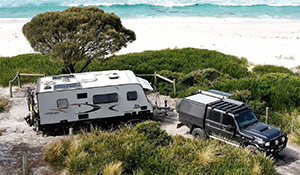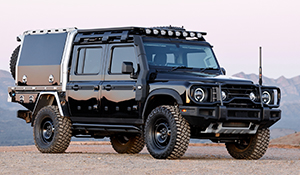2000 Mitsubishi Challenger Review
Originally released in March 1998, Challenger had established itself as a rugged but civilised 4WD wagon which was ideal for someone wanting the bold looks of a 4WD, the ground clearance to go camping or fishing at their favourite weekend hide-away, and the security of four-wheel drive. The new model built on the rugged looks that have been the trademark of Challenger, and heralded a new luxury model, the 'LS'.
The 2001 model year upgrade incorporated aggressive front and rear exterior styling changes. A new grille with a bold diagonal egg-crate design, and new headlamps with chrome surrounds which blended with the new front bumper, provided a more rugged look.
The revised rear bumper, rear combination lamps and tailgate garnish, and the addition of body side mouldings (on two-tone models) continued the luxury theme, while alloy wheels completed the picture.
The new 'LS' model had chrome mirrors and door handles, body-coloured rear spoiler and side step mountings, alloy wheels and fog lamps.
The 3.0-litre SOHC 24-valve V6 petrol engine was unchanged, delivering 136kW at 5500rpm, and maximum torque of 265Nm at 4500rpm. This power was put to the ground through Mitsubishi's 'Easy Select' part-time 4WD system which is fitted with a freewheeling front differential. Selection between 2WD and 4WD high range could be made on the run up to speeds of 100 km/hour. Standard transmission was a five-speed manual, with an optional four-speed automatic. Challenger's suspension was also upgraded to provide better road holding and a more refined ride.
The front suspension used unequal length double wishbones and torsion bars that provided responsive handling and ride qualities.
The rear rigid axle and leaf springs of the previous model were replaced by a 3-link rear end with coil springs. This provided a smoother, more supple ride with improved stability on loose surfaces.
Addressing criticism of ride quality, the new model featured carefully tuned spring rates and dampers, and front and rear stabiliser bars, in a more responsive package.
The interior of Challenger received a minor makeover, with the addition of a two-tone instrument panel and new centre console. The new centre console included a dual cupholder, which was previously located below the radio in the instrument panel. This allowed the redesign of the lower instrument panel to provide space for an in-dash CD changer, which was available as an option.
Standard Challenger features included dual SRS air bags, air conditioning, power windows, reclining front and rear seats, 60/40 split rear seat which folds flat, improved radio/cassette with CD controller function, power antenna, four-speaker audio, electric mirrors, central door locking, overhead console with sunglasses storage, fully carpeted floor and cargo area, and cargo area underfloor storage boxes.
Challenger LS added further items that move the vehicle into the premium category. The addition of a leather steering wheel, leather seats, woodgrain panel, radio/single CD with six speakers, and illuminated vanity mirrors for both driver and passenger provided an added upmarket feel.











